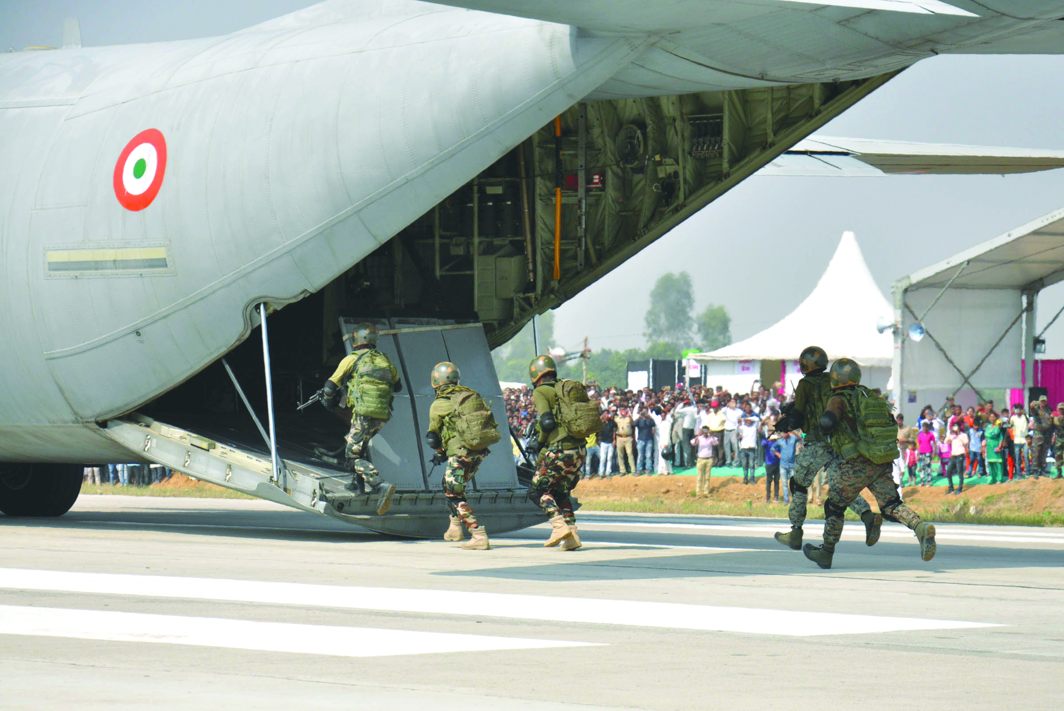Last week’s spectacle of Indian Air Force aircraft using the Lucknow-Agra Expressway has a vital strategic component

~By Praful Bakshi
When military strategists explain the term National Air Power as being the sum total of all the flying assets of a nation, they overlook the use of national highways as runways for military use. Not many civilians would be aware that the use of highways as air strips for take-off and landing of aircraft has been in practice since the two World Wars when the bombing of airfields led to the search for alternative sites. In fact, when the Indian Air Force (IAF) demonstrated this by landing a number of fighter and transport aircraft on the Lucknow-Agra Expressway, they brought out this important aspect in full view of the entire nation, and not just the crowds and VIPs who had gathered to watch the spectacle. Fighter aircraft like the Su-30s and Mirages, along with transport aircraft like C-130s, showed how, in the absence of real runways, highways can be used safely for take-offs and landings of these fighting machines in times of emergencies like war when dedicated runways might not be available to them.
India has a vast border over land and sea, running close to 10,000 km, and the present security scenario indicates a threat from all sides. There is a distinct possibility of Pakistan and China opening a combined front. This means India’s strategic assets will have to defend the western and north-western sector against Pakistan and the northern and north-eastern mountainous zone against China. There is also the joint threat of Chinese and Pakistan navies in the Bay of Bengal, and from the Indian Ocean to the Arabian Sea.
This massive military requirement brings up round-the-clock demand for the IAF to provide strike aircraft to destroy important targets in the enemy zone and tactical battle area, air defence fighters to provide cover to air and ground fighting assets as well as Vital Areas and Vital Points (Vas & VPs). However, the most important aspect is that IAF and military airfields would be under constant attack through ground attack fighters and surface-to-surface missiles which might lead to certain damage to these assets with the possibility of their being unavailable to our fighter aircraft.

The worst case scenario is two-three fighter formations returning from their attack missions running critically low on fuel and capable of only 15 minutes of flying, to find the home base runway is bombed out. The only option would be to find a place where the aircraft can be put down safely, turned around, refuelled and rearmed for the next mission. This was very common during the two World Wars when aircraft were light and slow, and could even land in open fields. With the advent of jet aircraft, this became difficult as the need was for a stronger landing surface for high-speed, heavier jets. Sweden showed the world how roads and highways could be used for tactical purposes. Since then, a number of countries have adopted this technique, including Singapore and Pakistan.
Looking at a different wargame scenario, if an army battalion has to be moved from somewhere in Maharashtra or Madhya Pradesh, with no airport nearby, it would take days for them to reach the battle area. In this scenario, the IAF can land on pre-determined portions of national highways and use heavy transport aircraft like the C 130 to pick up and carry the force to its target area quickly. There is also the humanitarian angle, wherein the air force may be asked to pick up victims or refugees from disaster zones to be conveyed to safer locations. Here aircraft like C-130s or AN-32s or even MI-17 helicopters could land on pre-determined stretches of various highways to carry out the mission.
Even in the case of counter-insurgency operations like in Chhattisgarh, Jharkhand, MP or anywhere in the Maoist-dominated Red Zone this exercise can be carried out to induct para-military or security forces. Such operations would, of course, be carried out with the help of mobile UAV operating teams to give the forces a real-time tactical picture.
However, the strategic priority is of operating combat aircraft from highways. For this, other ground preparations need to be in place, like maintenance teams to repair damaged combat aircraft, refuelling and rearming teams, fuel dumps and ammo dumps.
The present government has earmarked a large number of highways all around the country for this purpose, mostly in the northern sector like Gujarat, Rajasthan, UP, Punjab, MP, Bihar and in the East.
These are to be prepared by the respective state governments and kept ready to meet any eventuality.
Apart from roads and highways, an important aspect is overlooked, and that is the availability of a large number of abandoned wartime air fields, which have long runways, in fairly good shape. For example, between Kolkata to Kharagpur and right up to Jamshedpur, there are close to 36 abandoned air fields in Salua, Dudhkundi, Chakulia, Dalbhumgarh, Amardard Panagarh and Chaibasa, which could be reclaimed and put to good use.
The most advantageous aspect of this exercise is not only cooperation between the three services using a common resource, but total civil-military synchronisation in providing military aviation its most critical requirement—a safe stretch of highway for all take-offs and landings during operations.
The singular highway landing operation last week was largely passed off as a crowd-pleasing spectacle. What it was really meant to showcase was that the fighting assets of our country could be put to good use by proper civil-military cooperation, and strategic thinking and planning.


